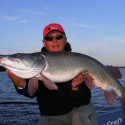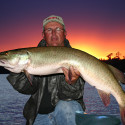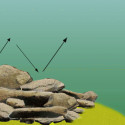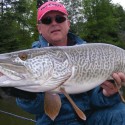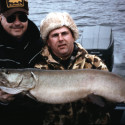By Joe Bucher, Editor Emeritus
Early season musky fishing is something that all musky nuts can’t wait to start doing, yet few are truly successful at catching fish during this period of time. You’ve heard all the excuses that “It’s too early,” “They’re still spawning, “The water’s too cold,” “We need some nice weather to get ’em going”. The list goes on and on, but for the most part none of it should hinder your ability to catch muskies in the early season. What you do need to know is where the muskies are, and what conditions and lures are going to trigger them to strike.
I’m not writing this article as an answer to all your spring musky fishing problems. There are certainly a lot waters that simply don’t provide a good early season bite. But on the other hand, some do. Those are the ones you want to key in on. You need to find a body of water that has the right set of conditions to turn on early season muskies. Then, simply eliminate fishing any place else until these conditions change. It’s just that simple.
With that in mind, I thought I’d give you a few examples of situations in which I have had consistent results with early season muskies. Along with that, I’ll try to give you a few ideas and reasons why these spots are so good, and we’ll also explore the best tactics to use in each circumstance.
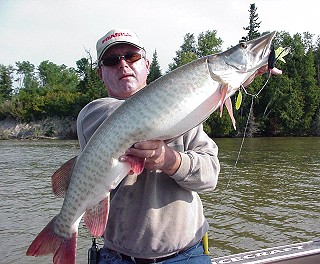 |
Find Early Weed Growth
Any time you find weed growth that is developed well early in the season, it is sure to be a musky hotspot. Beyond the obvious (that well-developed early season weeds will hold muskies because of the cover), there are several less conspicuous but more important reasons why early weeds are winners. The two that mean the most are warmer water and baitfish.
Early season weed development is a signal that this particular spot probably contains significantly warmer water. Most likely, these weeds are situated in an area receiving far more sunlight exposure, enhancing the photosynthesis process. More often than not, such spots are located near the northern end of a lake or in the back end of a long, secluded, shallow arm or bay. The warmer water and increased sunlight simply escalates the weed growth, much like your neighbor’s front yard of grass growing much quicker than all those in the surrounding neighborhood.
It’s important to note that the warmer water is the real attractant. Muskies and all the other fish in the area will gravitate to it. Weeds might just so happen to be the cover that happens to be there. In fact, weeds could easily be replaced by any other cover element such as reeds, wood, brush or even rocks and still attract the fish with equal value. All the warm water fish species in the ecosystem will be seeking out this warm water area for spawning and feeding. Think of it as one big festival and everyone wants to be there.
Any portion of that weed patch that becomes emergent, no matter how small, is sure to be the spot-on-the-spot. Why? The answer again is simple and it is the key to so much of this early season success. Once any part of that plant breaks water, it becomes a superior heat conductor. Heat means warmer water. Warmer water means baitfish concentrations. Baitfish concentrations means MUSKIES nearby! It’s almost too easy in this case, and predictably accurate nearly all the time. What I mean by this is, anytime you are fishing a shallow weedbed early in the season and notice a specific area or chunk of that weed bed that has protruding, emergent tassels sticking out above the water’s surface, casts made to that specific spot are likely to draw the largest percentage of strikes. Period.
Muskies and other gamefish like bass and pike really lock on to those individual weed patches that pop out to the surface first. In addition, it really pulls the fish up vertically near the surface. I think anytime this happens it makes the fish more aggressive as well as making the fish more susceptible to presentations. But the underscored factor in this unique circumstance is often what happens to the fish that muskies like to eat. As you will read throughout this article, I believe that these early season emergent spots draw baitfish like magnets due to their superior solar heat generation. Minnows, perch, crappies and other morsels that muskies like to munch on all lock on to these plants that are taller than the rest. The ones that pop out above the water’s surface draw musky baitfish like flies. And, they will almost always be tight to the weeds and right up near the surface in order to take advantage of the warmer water and solar heat.
The best bait to fish over and around these early emerging weed patches can vary. I’ve had great success with a variety of lures in this instance. Traditional bucktail spinners are tough to beat, especially on overcast days with any kind of wave action. Of course, it’s important to cast this bait beyond the target patch so you can get it spinning fast and riding high before it reaches the weed clump itself. Otherwise, you are likely to mess up the spot by fouling your lure with weeds and destroy your chances of triggering a hot fish that may be right where your lure dropped. Whenever possible, always cast beyond the intended target (the emergent weed clump), and retrieve the bait back toward it. This also allows you to adjust your speed and the travel level of the bait.
For submergent weed cover, it’s tough to beat a minnowbait early in the season — especially after cold fronts, whenever the skies are bright and blue. Muskies are still there, but sure to be hugging tighter to the weeds clumps and deeper. It will often take several casts to the same spot at various angles and a variety of jerks, pauses, and twitches to trigger a response.
Anytime a weed patch is isolated and off shore, take the time to work it from a variety of angles. If a fish has followed from the patch, work it more thoroughly and slowly with a minnowbait worked in a jerkbait fashion. I can’t tell you how many times I’ve had success with this tactic during the early season in cold fronts. These fish are just reluctant to move, yet the perfect cast and the right jerk action that puts that bait right in front of his/her nose can still trigger the strike.
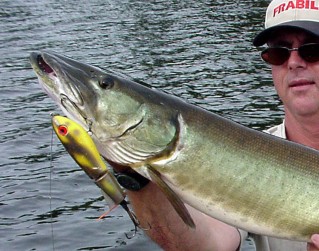 |
This is also a key time to break out your favorite topwater plug and give it whirl. This is particularly true once the tassels of newly emerging cabbage weeds break the surface. I pulled this off most recently last spring on one of my first true musky outings of the year while filming a TV segment for our show. It was late afternoon, and the weather had been on a strong warming trend for over four days now — a great condition for early season topwater. I’d been itching to dust off a TopRaider anyway, and I had a new mallard duck pattern I was anxious to try. The weed flat I was fishing had already produced enough footage for a couple of walleye shows for me earlier in the day, and I had noticed some emerging tassels on a few spots up shallow. I also noticed a lot of baitfish activity in those same patches. As I launched the first few casts I immediately went into an audio introduction of how productive these emerging weed patches can be for early season fish, as I was demonstrating how to fish a
TopRaider through the surfacing tassels. Right on cue, a 43-incher roared out of the first patch I cast to and smashed the bait. I had only made two casts!
After the battle and release, I repaired the wire leader, checked my line, resharpened my hooks and stood up to start this thing all over again. Within a few casts I had another musky, an even bigger 45 incher, react the same way. I had taken two nice fish and filmed one of my best segments of the year within a few casts! What a way to start the season!
Bulls of the Rushes
Reeds, bulrushes and similar sand flat plants can also be super attractors for early season muskies. Springtime is, without question, the top time to fish such spots. Anytime shallow, extended sand flats dominate a lake’s landscape, and reeds are present, it’s almost a sure bet that a lot of muskies will be using them. The more isolated the reeds are, the easier it is to pinpoint where the muskies are likely to be. However, lakes with big flats of reeds that stretch across several football fields are apt to hold a lot more muskies overall.
One peculiar thing I have noticed about reeds and their early attraction value is that exposed emergent clumps of dead reeds attract more baitfish and consequently muskies, as well. This is especially true during midday conditions with any degree of sunshine. The answer to this riddle is quite amazing once you think about it, and once again the power of the sun comes into play. The emergent clumps of brownish dead reeds are a Mother Nature-built solar cell. These unique spot-on-the-spot locations absorb far more solar heat than any surrounding reeds that are scattered or submerged. In fact, if you are able to slip along a reed flat quietly enough, and watch closely with good polarized sunglasses, you will often notice that these emergent clumps of dead reeds contain hordes of minnows right underneath and alongside the canopy. They might also have a group of crappies hovering underneath them, as well. Whenever the sun is out, these fish are sure to be right up near the surface where all the additional solar heat (warming water) is being generated. A musky or two is sure to be nearby.
Spawning muskies simply love these shallow reed flats, and if the water is clear, you can often see them cruising across these spots in mere inches of water. What’s interesting here is that muskies will usually hang around these reed flats for weeks after the spawn while they recuperate. They’re often spotted next to a thicker reed clump. The reason is now is obvious — heat, cover, and baitfish.
Sight fishing these rascals with soft plastics has become a recent rage. Quite often a single hook rig is superior due to the cover complications of fishing in reeds with conventional treble hook lures. Big Slug-Go-style plastics rigged Texas-style (large 6/0 to 8/0 single hook buried into the plastic to make it self-weedless) are the best way to go utilizing one of the new superbraid lines. In fact, I have admittedly gone wireless (no wire leader) for this tactic with surprising success and no bite-offs to date. A wire leader really destroys the action on this sensitive-action bait. I have filmed several TV segments on this technique recently and am still surprised at the results and frustrated that I didn’t try it earlier in my musky days. It is one heck of a lot of fun to catch muskies on these soft plastic jerk worms, and man do they tear the place up after you set the hook!
Spinnerbaits are also worthy weapons of war on these spring reed muskies, and I’ve had some of my greatest early season outings with these age-old lures. They are particularly good on overcast days with a chop of any kind (wave action). Dark, rainy overcast weather has reigned supreme for spinnerbait muskies in the reeds.
Now, I’m not talking about large spinnerbaits for this style of fishing. Forget those big monstrous contraptions for this method. A traditional 3/8- to 1/2-ounce long wire arm bass spinnerbait has been my best musky lure overall. In particular, I have had great success with a homemade version that sports a No. 3.5 Colorado in hammered brass blade anchored by a No. 5 Willow in hammered nickel. A white or white/chartreuse skirt and a 4-inch white plastic trailer rounds out the best spring reed musky lure I’ve ever used.
Make sure you seek out spinnerbaits that utilize larger premium grade hooks. Spinnerbait hooks, in general, tend to be strong and stout, but they will be tested to the limit on a twisting, turning, tornado of a musky rocketing through the reeds after being hooked. I make my own spinnerbaits utilizing a premium grade 6/0 ultra-sharp single hook. In fact, I have recently found some 7/0 premium grade spinnerbait hooks made by Gamakatsu that I plan to incorporate on some new spinnerbaits for this coming spring. A big, strong, superior grade single hook that is ultra sharp is vital to hooking and holding a big musky in reeds.
The neat thing about the bass spinnerbait is that it so easily adapts to musky fishing. In fact, most of today’s good musky outfits will cast a 1/2-ounce bass spinnerbait quite easily. I use the same 7-foot-6 rod that I typically use for bucktail fishing the rest of the season. The specifics of this outfit are a St. Croix Avid AM76MHF (medium heavy power), Avid 300 baitcast reel, and Stren’s new Super Braid in 65-pound test. I tie direct; no wire leader. Wire leaders with spinnerbaits are a no-no in my book. They really mess with the balance of the spinnerbait and are forever fouling around the spinnerbait’s wire arm. The wire arm of the spinnerbait itself acts as a wire leader. The durability of the new braid lines also reduces the possibility of a bite-off.
Brush Busters
A discussion of spring musky locations and tactics would never be complete without at least touching on wood, brush and timber as a spring musky haunt. A common theme throughout this entire article has been finding warm water, cover and baitfish. Along this journey, you are going to encounter warm bays and shorelines that are littered with stumps, brush, fallen trees and old log pilings. All of these have a high attraction value to muskies as well as all the things that muskies like to eat. Replace
the weeds or the reeds in a bay or sun-baked flat with any kind of wood and the end result is the same — everything in the ecosystem wants to be there. Of course, this also makes it a musky magnet.
Oddly enough, it doesn’t always take a lot of wood to attract and hold a spring musky. In a deep, clear, coverless lake, a single log can be the answer. A number of the deep clear lakes in my hometown area in Vilas County, Wisconsin, have such a scenario. You can ease along a shallow, coverless flat with your trolling motor and actually spot muskies and other fish next to any small piece of woody cover that exists, no matter how small and insignificant it looks at first.
It’s all basically relative. The more woody cover there is, the more potential it has to hold numbers of fish instead of singles. The important thing to remember here is that
wood is a big attractor to early season muskies. Unlike weeds or reeds, it is a more permanent form of cover. What I mean by that is it is likely to be in the same spot year after year. Once you find a woody area that attracts early season muskies, it is sure to be good year after year. It is also important to note that these spots will be equally productive whether they exist in a shallow, stained lake or a deep, clear one.
One of the best early season woody musky spots I’ve ever encountered exists on a deep clear lake void of any weed cover or reeds. This spot is classically situated on the far north end of the lake which, as we know now, draws all the warmest water and baitfish activity. It even has a little mini bay off shoot at one end that is almost like a separate lake. This little mini bay is, of course, even warmer on sunny afternoons than the rest of the surrounding area, and because of that, it can draw incredibly large groups of muskies up into a very tight, confined area at times. In fact, these fish get so stacked up here that I have to admit that it should be illegal to fish ’em in this instance. Rumors of big fish being snagged out of this particular spot circulate every spring, and are not uncommon because the fish just suck up into this pocket as soon as the sun comes out and warms the water. It’s an incredible sight for sure.
Not all woody spots are this unique yet it is always important to make a good “recon” of any wood cover in the spring. Remember that anytime a chunk of wood is exposed to direct sunlight, such as a partially emergent “dead head” or a stump or a fallen tree with portions of the trunk or branches above the water’s surface, it is likely to hold higher potential at this time. And, because this cover is rigid, you will have to be careful how you fish it so you won’t get your lure tangled and mess up the spot.
Remember, one of my favorite rules of thumb — when cover is submergent, treble hooks are OK. When cover is emergent, single hooks are the way to go.
Conventional musky lures will perform in wood if you have water over the cover. Twitching minnowbaits, burning small bucktails and even bouncing crankbaits off this stuff can all work then. But, when it is sticking out of the water, grab that single hook spinnerbait or some form of soft plastic lure that contains a single hook rigging system.
Well, there it is. Three good patterns for you musky hunters to try this spring. Those of you who just can’t wait for the water to warm, the weather to improve, the spawn to finish, or whatever else the reason might be, will just have to put your boat in the water and go give these ideas a try. Don’t forget — finding warm water is always the key. Locate cover in these spots and you’ll be on your way to catching early season muskies. Also, never underestimate the power of one emergent piece of cover. Solar heat is a major attractor. Once you find an early season hotspot, try to keep it a secret. You know what? They probably wouldn’t believe you anyway!
Editor Emeritus Joe Bucher is the host of the “Fishing with Joe Bucher” and “Hunting with Joe Bucher” TV series. He lives near Eagle River, Wisconsin.

